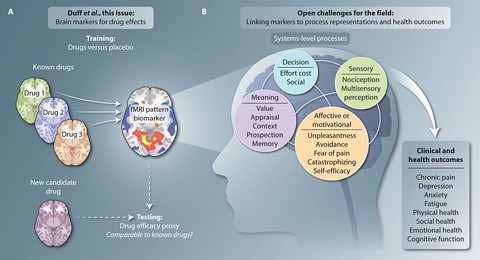February 16, 2016 - Using functional magnetic resonance imaging (FMRI), to measure the brain’s neural response to pain, may be a viable tool for evaluating the effectiveness of new pain medications during the early stages of human drug development – providing the needed objective evidence to prevent the premature discarding of potentially beneficial therapies, according to a recent study published in Anesthesiology.
The therapeutic effects of centrally acting pharmaceuticals can manifest gradually and unreliably in patients, making the drug discovery process slow and expensive. Biological markers providing early evidence for clinical efficacy could help prioritize development of the more promising drug candidates.
Although researchers have used FMRI to characterize how drugs cause changes in brain activity, variation in study protocols and analysis techniques has made it difficult to identify consistent associations between subtle modulations of brain activity and clinical efficacy. The authors of this study presented and validated a general protocol for functional imaging-based assessment of drug activity in the central nervous system. The protocol uses machine learning methods and data from multiple published studies to identify reliable associations between drug-related activity modulations and drug efficacy, which can then be used to assess new data. A proof-of-concept version of this approach was developed and is shown for analgesics (pain medication), and validated with eight separate studies of analgesic compounds.
Their results show that the systematic integration of multistudy data permits the generalized inferences required for drug discovery. Multistudy integrative strategies of this type could help optimize the drug discovery and validation pipeline.

Figure: Examining brain mediators of drug effects. (A) Duff et al. provide a framework for assessing new candidate drugs in terms of whether their effects on the brain are comparable with other, known drugs. (B) Open challenges for the field include understanding how drugs influence multiple, systems-level brain processes; how these processes mediate the drug effects on clinical and health outcomes (such as chronic pain, depression, or fatigue); and how fMRI markers for these processes can be used to predict those health outcomes. Figure and legend from Wager and Woo, with permission from AAAS.2
Source:
1. Duff EP, Vennart W, Wise RG, Howard MA, Harris RE, Lee M, Wartolowska K, Wanigasekera V, Wilson FJ, Whitlock M, Tracey I, Woolrich MW, Smith SM. Learning to identify CNS drug action and efficacy using multistudy fMRI data. Sci Transl Med. 2015 Feb 11;7(274):274ra16. doi: 10.1126/scitranslmed.3008438.
2. Ahmed AK. Brain Imaging-Based Drug Assessment Procedure Can Predict Clinical Efficacy of Pain Relievers. Multi-study proof-of-concept method could provide “Go/Stop” decisions to streamline drug discovery. Pain Research Forum. 16 Mar 2015. http://www.painresearchforum.org/news/51719-brain-imaging-based-drug-assessment-procedure-can-predict-clinical-efficacy-pain.




